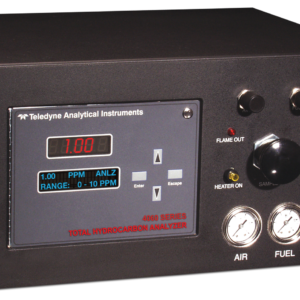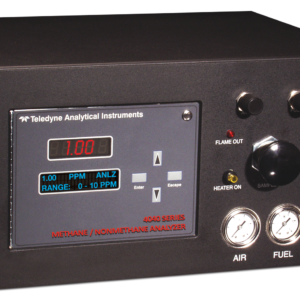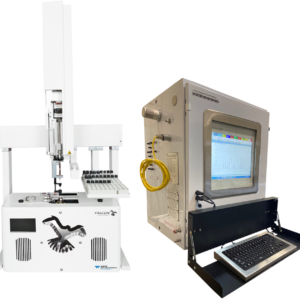The 4060 Series speciates gases of interest by combining well-accepted gas chromatography techniques with field-proven detector technologies. This combination, along with effective electrometer-based signal amplification and temperature controls, enables the series to detect either single or multiple compounds in a background gas possessing potentially interfering compounds.
- Brand
- DETAILS
- FEATURES
- SPECIFICATION
Brand
Teledyne Analytical TAI
DETAILS
Gas Chromatography
Gas chromatography effectively separates components using a specially designed packed column made of inert stainless steel tubing filled with porous polymer particles or bonded phase materials tailored to specific applications. The coating’s interaction with smaller, more volatile compounds is minimized, enabling these compounds to travel through the column more rapidly than their larger, less volatile counterparts.
In certain instances, multiple columns may be utilized to ensure a rapid and comprehensive analysis of the desired parameters. An inert carrier gas propels the sample through the column at a controlled flow rate. By maintaining precise temperature and pressure, the exit times for each gas can be consistently replicated. After exiting the column, the sample moves to the detector, where the sensor response is integrated to determine the volumetric concentration of the gas of interest over time.
Sample System
The sample system is sealed, insulated and utilizes PID controllers to ensure the ultimate temperature stability of the switching valve and column/detector compartment. Tubing, fittings and components are 300-series stainless steel and teflon. All adjustable pressure and flow devices are easily accessible from the front panel and both the rack and wall-mount configurations provide easy access to the sample system components for maintenance.
The 4060 Series utilizes a switching valve with two states. It starts with the collection of precise volume of the sample while bypassing the carrier gas to the vent. The valve is then actuated to an analysis state where the speciated gas of interest is then pushed through the sample loop by the carrier gas and on to the detector for analysis. The signal peaks are then collected and the gas concentration is measured and displayed.
Detector Technologies
Flame-Ionization Detector (FID)
Due to its high sensitivity to most organic compounds, the flame-ionization detector is a powerful tool for measuring hydrocarbon impurities in gases as well as providing a linear response over a wide range of analysis. Organic compounds from the sample stream or separation column are injected into the detector housing where they are mixed with hydrogen and air before entering the detector jet where the mixture is burned.
During this process, organic compounds are broken down into carbon fragments and acquire a positive charge (i.e., become ionized) at the surface of the anode. Carbon fragments are detected by the collector and the signal is then amplified and sent to the data processing system.
Thermal Conductivity Detector (TCD)
The thermal conductivity detector measures levels of a gas by its ability to conduct heat. The cell block is heated to a fixed temperature that consists of four filaments arranged in a Wheatstone Bridge configuration. Two filaments are exposed to a reference gas (sealed or flowing) of a known thermal conductivity while the other two see the sample gas being measured. A reference voltage is also applied across the bridge.
If the measuring filaments are exposed to a gas of the same thermal conductivity as the reference filaments, the bridge will be balanced (the differential voltage will be zero). However, if the thermal conductivity of the measuring gas changes, the filaments’ temperature will increase or decrease respectively. This change will affect the electrical resistance across filaments, which creates a measurable voltage differential proportional to the volumetric concentration of the gas of interest.
Tracs™ software
Tracs™ software is a unique program used to unveil chromatogram and compound retention sequences on which concentrations of compounds of interest are calculated. It provides valuable access for an ordinary user to look inside the complicated GC world with a computerized tool. It suits the need for high accuracy in GC techniques and for ease of communication in digital formats.
- Bi-directional communication of analyzer’s range, alarm and timing settings which can be remotely uploaded and downloaded
- Acquires real-time raw data for continuous display of chromatograms
- Elution peaks can be displayed within their own respective time frames or individually manipulated for optimal peak scrutinization
- Statistical summary including analytical calculation of measurements, distribution of values and deviations
- Data-logging
- Saving and retrieving of digitized data files
Advantages
- Ease of troubleshooting and root-cause diagnosis
- Faster and more comprehensive factory technical support
- Better analyzer performance monitoring and measurement evaluation
I/O
- 0-1 VDC and 4-20 mADC (isolated) analog outputs
- 0-1 VDC and 4-20 mADC gas identification outputs
- RS-232 duplex digital output
- Two (2) fully-configurable concentration outputs with Form-C relay contacts
- System alarm with Form-C relay contact
- Next Generations will have up to four (8) gas identification outputs, Form-A type
Common Detectable Gases
4060 FID
| Acetaldehyde Acetylene Benzene Butane Carbon Dioxide* Baron Monoxide* | Ethane Ethyl Benzene Ethylene Hexane Methane MTBE | Propane Propylene THC Toluene VOCs Xylene |
*Measurement achieved with methanizer
4060 TCD
| Argon Impurity Argon Purity Carbon Dioxide Carbon Monoxide | Helium Hydrogen Hydrogen Sulfide Krypton | Nitrogen Impurity Nitrogen Purity Xenon |
FEATURES
Electronic Interface Features
- Field proven microprocessor based electronics provide menu driven functionality
- Easy-to-view 5-digit LED display for readings
- 2 x 20 vacuum fluorescent display menu options, settings and status
- Built-in diagnostic capability
- EEPROM to store factory defaults in the event of loss of power
- Ready for auto-calibration and remote-calibration with external solenoid valves (integral cal valves available as option)
- Automatic flame ignition/re-ignition and flame-out guard circuitry (for FID detector)
- Methanizer available with FID version for detection of carbon dioxide and carbon monoxide
SPECIFICATION
| Sensing Technology | Flame-Ionization Detector (FID) |
| Gas and Ranges | 4060 FID Hydrogen compounds Trace or percent level detection (contact factory to verify application) 4060 TCD Most Gases Trace or percent level detection (contact factory to verify application) |
| Sensitivity | 1% of FS |
| Accuracy | ± 2% of FS (at constant temperature) |
| Repeatability | 1% of FS through all ranges |
| Response Time | Application Dependent |
| Temperature | 40° to 110°F (4° to 43°C) |
| Noise | Less than 0.5% of FS |
| Drift | 2% of FS per week |
| Outputs | 0-1 VDC and 4-20 mADC isolated (one output with gas ID for 3+ gases) |
| Supply Voltage | 110 to 220 VAC, 50/60 Hz |
| Sample Flow Rate | 1 SCFH (0.5 LPM) Standard |
| Dimensions | 4060 FID 19″W x 8.75″H x 22.5″D (48.26 x 22.23 x 57.15 cm) 4060 TCD 19″W x 8.75″H x 16.5″D (48.26 x 22.23 x 41.91 cm) |







